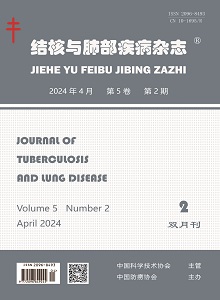-
Influence of two anesthesia methods on T lymphocyte subsets, NK cells and interferon gamma in spleen of mice infected with BCG vaccine
- LIU Min-qiang, HAN Ya-kun, WANG Song, LI Zhi-chao, YU De-hui, WANG Hua, HE Ren-liang
-
Journal of Tuberculosis and Lung Health. 2017, 6(3):
229-234.
doi:10.3969/j.issn.2095-3755.2017.03.000
-
 Abstract
(
197 )
Abstract
(
197 )
 PDF (2380KB)
(
400
)
PDF (2380KB)
(
400
)
 Save
Save
-
References |
Related Articles |
Metrics
Objective To compare the influence of general anesthesia and intravertebral anesthesia on T lymphocyte subsets, NK cells and interferon gamma in spleen of mice infected with BCG vaccine. Methods Fifty-four clean healthy male C57BL/6 mice were randomly divided into general anesthesia group (group G), intravertebral anesthesia group (group S), and control group (group C) with 18 cases each according to random number table and were established animal model infected with BCG. Each 6 mice from every group were sacrificed and calculated the CD3+, CD4+ and CD8+T lymphocyte, CD4+/CD8+ T lymphocyte ratio, natural killer cells (NK cells) and interferon gamma (IFN-γ) expression of spleen tissues using flow cytometer in 30 minutes before operation, 1 day after the operation and 3 days. Results The CD4+/CD8+ T lymphocyte ratio, NK cells and IFN gamma were 2.8±0.3 and 2.9±0.2, (22.3±2.3)% and(22.8±1.9)%, (1.4±0.4)% and (1.4±0.4)% in the 30mins before operation, 1.8±0.2 and 1.8±0.1, (15.6±1.4)% and (15.2±1.1)%, (0.6±0.2)% and (0.6±0.3)% in the first day after operation, 2.0±0.2 and 2.1±0.2, (18.7±2.0)% and (19.1±2.3)%, (1.1±0.2)% and (1.1±0.2)% in the third day in group G and group S, respectively. The comparison of values in three groups were in different time points were different significantly(F values were 65.40 and 83.02,41.30 and 53.65,27.77 and 7.47,all P were 0.000). In the third day after operation, the CD3+ T lymphocytes((20.9±3.1)% and (21.0±3.2)%), CD4+ T lymphocytes((13.9±1.9)% and (14.1±2.2)%) in Group G and S were lower those((26.5±5.1)% and (18.4±4.1)%) in the group T with significant difference statistically(F=8.00,P=0.001;F=8.54,P=0.001). The CD4+T lymphocytes in the third day after operation were lower those in the 30 min before operation((18.2±4.2)%, (17.8±3.5)%) with significant difference statistically(t=13.36,P=0.005;t=4.19,P=0.006). However, in the third day after operation, the CD3+ T lymphocytes((20.9±3.1)% and (21.0±3.2)%), CD4+ T lymphocytes((13.9±1.9)% and (14.1±2.2)%), CD4+/CD8+ T lymphocyte ratio((2.0±0.2) and (2.1±0.2)) and NK cells((18.7±2.0)% and (19.1±2.3)%) and IFN gamma((1.1 ± 0.2)% and (1.1 ± 0.2)%) were no significant difference in group G and S(t values were 0.12, 0.23, 0.39, 0.39 and 0.46,P were 0.902, 0.821, 0.697, 0.697 and 0.660). Conclusion T lymphocyte subsets, NK cells and IFN gamma expression in the spleen of mice infected with BCG can be inhibited by anesthesia, but CD3+ T lymphocytes, CD4+ T lymphocytes, NK cells, IFN gamma and CD3+/ CD4+ T lymphocyte ratio are no significant difference statistically in general anesthesia and intravertebral anesthesia.

 Wechat
Wechat